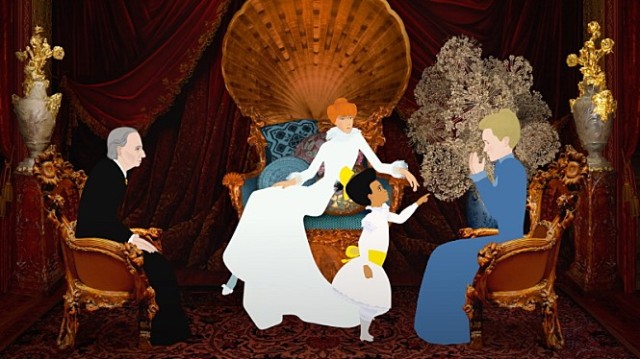
I was ready to enjoy French animation feature film “Dilili in Paris”, but it did not satisfy me enough. Sure, the film provides a number of lovely visual moments to be appreciated, and I was amused by the frequent appearance of real-life figures throughout the film, but it is also hampered by its thin narrative and superficial characterization especially during its second half. Although the overall result is admirable in technical aspects, the film often feels like the overextended version of a animation short film, and I found myself checking my watch from time to time despite its short running time (94 minutes).
During the opening scene which comes to reveal its absurd and twisted aspect in the end, we are introduced to a little Kanak girl named Dilili (voiced by Prunelle Charles-Ambron), and then we see how things have been pretty good for her since she came to Paris some years ago. Although it is around the early 20th century and she naturally faces racial prejudice at times as a girl of mixed blood, she does not mind that at all while comfortably staying in a big mansion belonging to some rich countess, who has been her guardian since she was found on a ship sailing to France (She never appears in the film, by the way).
Anyway, when she is doing a sort of part-time job during the opening scene, Dilili happens to encounter a young scooter deliveryman named Orel (voiced by Enzo Ratsito), and they instantly become close friends although they are total strangers to each other from the beginning. While quite surprised by how courteous and sophisticated Dilili actually is, Orel is willing to befriend Dilili, and Dilili is surely excited to have a friend who will take her to here and there in the city.

However, they are soon reminded of a certain mysterious menace lurking around the city. There is a secret criminal organization which has terrorized the citizens of Paris, and it has been particularly notorious for kidnapping young girls for some unknown purpose. After she is almost kidnapped by a member of this criminal organization at one point, Dilili becomes determined to track down this criminal organization although she is just a small kid, and Orel is certainly ready to help her.
Fortunately for them, Orel happens to be acquainted with a number of famous real-life figures who may provide them some help or information. First, they meet a group of young rising artists including Pablo Picasso and Henri Matisse, and that is just the beginning. Besides other prominent artists of the Belle Époque such as Claude Monet, Henri de Toulouse-Lautrec, and Auguste Rodin, they also meet Louis Pasteur and Marie Curie, and they later come across Prince Edward of England while trying to stop the latest crime of the criminal organization.
As these numerous historical figures come and go, the film constantly provides several wonderful scenes via its cell animation style. When Dilili and Orel visit a well-known singer named Emma Calvé (voiced by Natalie Dessay), she is singing a new song composed by Claude Debussy on a big swan boat floating on an underground pool, and then we are treated with a rather spooky moment as she and our two main characters go through the intricate underground sewer system of the city. In case of a part involved with Toulouse-Lautrec, we see those cancan dancers of the Moulin Rouge as expected, and then we get a brief but jolly moment when Toulouse-Lautrec has a little but precious moment of joie de vivre along with Dilili and Orel.

Eventually, Dilili and Orel come to discover what the criminal organization has been planning at its underground lair, and the situation becomes a little darker as Dilili is taken to that underground lair, but that is where the story comes to lose its narrative pacing as well as its charm and spirit. While the story seems to be trying to deliver a serious social message as Dilili and other several female characters in the story stick together for stopping a deplorably misogynous criminal mastermind behind the criminal organization, their opponent is a rather unimpressive villain, and it is all the more disappointing to see that the supposedly urgent situation in the story is resolved too easily and languidly in the end.
As I became more dissatisfied with the film, my mind was taken back to director/writer Michel Ocelot’s two previous works “Kirikou and the Sorceress” (1999) and “Tales of the Night” (2011). Sure, they also show some weak points in terms of story and character, but these two cell animation films have enough charm and style to compensate for their flaws at least. While I came to admire the plucky spirit of that tiny hero of “Kirikou and the Sorceress”, I also loved the simple but undeniably beautiful cell animation style of “Tales of the Night”, and I certainly had a good time as watching these two animation film together during one evening.
Compared to these two previous works by Ocelot, “Dilili in Paris” is less impressive on the whole, and I must tell you that it soon began to be faded away from my mind as I subsequently revisited Hayao Miyazaki’s great animation film “My Neighbor Totoro” (1988), which happened to be re-released in South Korean theaters a few weeks ago. While it is fairly charming and likable, I still think the film could be improved more through tighter storytelling with more depth, so I cannot recommend it, but I will not stop you if you simply want to kill your free time – or if you just want to see something different from those run-of-the-mill digital animation films out there.







